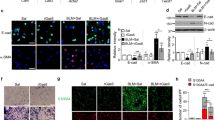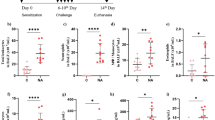Abstract
Background and objective
Acute lung injury or acute respiratory distress syndrome (ALI/ARDS) is a life-threatening respiratory disease. Gp130 is a signal transduction receptor that participates in a variety of essential biological processes. The biological function of gp130 in ALI/ARDS is unclear. This study aims to investigate the roles and potential mechanisms of gp130 in lung injury induced by lipopolysaccharide (LPS).
Methods
The ALI/ARDS mouse model was established using intratracheal LPS administration. Hematoxylin and eosin staining and bronchoalveolar lavage fluid analysis were used to evaluate the degree of lung injury. Cell apoptosis was assessed by TUNEL staining, flow cytometry, and western blot. Then the expression of gp130, IL-6, IL-10, TNF-α, and the JAK1/STAT3 signaling pathway-related proteins was assessed by RT-PCR, western blot, and immunohistochemistry.
Results
The expression of gp130 increased after 24 h of LPS treatment. Inhibiting gp130 improved inflammatory infiltration and alveolar collapsed, decreased IL-6 and TNF-α levels, raised IL-10 levels, and decreased cell apoptosis in LPS-induced mice. Meanwhile, suppressing gp130 reduced the inflammatory response and cell apoptosis in LPS-induced Beas-2B cells. Furthermore, p-JAK1 and p-STAT3 expressions were elevated after LPS stimulation and decreased following gp130 inhibition, suggesting that gp130 may regulate the JAK1/STAT3 signaling pathway in LPS-induced mice and Beas-2B cells.
Conclusion
The findings suggest that gp130 regulates the inflammatory response and cell apoptosis through the JAK1/STAT3 signaling pathway, thereby mitigating LPS-induced lung injury. Gp130 may be a potential therapeutic target for ALI/ARDS.








Similar content being viewed by others
Data availability
The datasets generated during the current study are available from the corresponding author on reasonable request.
Abbreviations
- ALI:
-
Acute lung injury
- ARDS:
-
Acute respiratory distress syndrome
- CNTF:
-
Ciliary neurotrophic factor
- DMSO:
-
Dimethyl sulfoxide
- DAPI:
-
4′,6-Diamidino-2-phenylindole
- FBS:
-
Fetal bovine serum
- Gp130:
-
Glycoprotein 130
- HE:
-
Hematoxylin and eosin
- LPS:
-
Lipopolysaccharide
- LIF:
-
Leukemia inhibitory factor
- PBS:
-
Phosphate buffer solution
- PMSF:
-
Phenylmethyl sulfonyl fluoride
- PVDF:
-
Polyvinylidene fluoride
- RT:
-
Room temperature
- SPF:
-
Specific pathogen-free
- TUNEL:
-
TdT-mediated dUTP nick end labeling
References
Bellani G, Laffey JG, Pham T, Fan E, Brochard L, Esteban A, et al. Epidemiology, patterns of care, and mortality for patients with acute respiratory distress syndrome in intensive care units in 50 countries. JAMA. 2016;315:788–800. https://doi.org/10.1001/jama.2016.0291.
Matthay MA, Zemans RL, Zimmerman GA, Arabi YM, Beitler JR, Mercat A, et al. Acute respiratory distress syndrome. Nat Rev Dis Primers. 2019;5:18. https://doi.org/10.1038/s41572-019-0069-0.
Pham T, Rubenfeld GD. Fifty years of research in ARDS. the epidemiology of acute respiratory distress syndrome A 50th birthday review. Am J Respir Crit Care Med. 2017;195:860–70.
Ciesielska A, Matyjek M, Kwiatkowska K. TLR4 and CD14 trafficking and its influence on LPS-induced pro-inflammatory signaling. Cell Mol Life Sci. 2021;78:1233–61. https://doi.org/10.1007/s00018-020-03656-y.
Lv H, Liu Q, Wen Z, Feng H, Deng X, Ci X. Xanthohumol ameliorates lipopolysaccharide (LPS)-induced acute lung injury via induction of AMPK/GSK3β-Nrf2 signal axis. Redox Biol. 2017;12:311–24. https://doi.org/10.1016/j.redox.2017.03.001.
Rose-John S. Interleukin-6 family cytokines. Cold Spring Harb Perspect Biol. 2018. https://doi.org/10.1101/cshperspect.a028415.
Li Y, Feng J, Song S, Li H, Yang H, Zhou B, et al. gp130 controls cardiomyocyte proliferation and heart regeneration. Circulation. 2020;142:967–82. https://doi.org/10.1161/circulationaha.119.044484.
Schmidt-Arras D, Galun E, Rose-John S. The two facets of gp130 signalling in liver tumorigenesis. Semin Immunopathol. 2021;43:609–24. https://doi.org/10.1007/s00281-021-00861-0.
Silver JS, Hunter CA. gp130 at the nexus of inflammation, autoimmunity, and cancer. J Leukoc Biol. 2010;88:1145–56. https://doi.org/10.1189/jlb.0410217.
Xin P, Xu X, Deng C, Liu S, Wang Y, Zhou X, et al. The role of JAK/STAT signaling pathway and its inhibitors in diseases. Int Immunopharmacol. 2020;80:106210.
Darnell JE Jr. STATs and gene regulation. Science. 1997;277:1630–5. https://doi.org/10.1126/science.277.5332.1630.
Ling L, Zhang SH, Zhi LD, Li H, Wen QK, Li G, et al. MicroRNA-30e promotes hepatocyte proliferation and inhibits apoptosis in cecal ligation and puncture-induced sepsis through the JAK/STAT signaling pathway by binding to FOSL2. Biomed Pharmacother. 2018;104:411–9. https://doi.org/10.1016/j.biopha.2018.05.042.
Hu L, Liu R, Zhang L. Advance in bone destruction participated by JAK/STAT in rheumatoid arthritis and therapeutic effect of JAK/STAT inhibitors. Int Immunopharmacol. 2022;111:109095.
Georas SN, Donohue P, Connolly M, Wechsler ME. JAK inhibitors for asthma. J Allergy Clin Immunol. 2021;148:953–63. https://doi.org/10.1016/j.jaci.2021.08.013.
Wang L, Hu Y, Song B, Xiong Y, Wang J, Chen D. Targeting JAK/STAT signaling pathways in treatment of inflammatory bowel disease. Inflamm Res. 2021;70:753–64. https://doi.org/10.1007/s00011-021-01482-x.
Kida H, Mucenski ML, Thitoff AR, Le Cras TD, Park KS, Ikegami M, et al. GP130-STAT3 regulates epithelial cell migration and is required for repair of the bronchiolar epithelium. Am J Pathol. 2008;172:1542–54. https://doi.org/10.2353/ajpath.2008.071052.
Yang HH, Duan JX, Liu SK, Xiong JB, Guan XX, Zhong WJ, et al. A COX-2/sEH dual inhibitor PTUPB alleviates lipopolysaccharide-induced acute lung injury in mice by inhibiting NLRP3 inflammasome activation. Theranostics. 2020;10:4749–61. https://doi.org/10.7150/thno.43108.
Kerr NA, de Rivero Vaccari JP, Weaver C, Dietrich WD, Ahmed T, Keane RW. Enoxaparin attenuates acute lung injury and inflammasome activation after traumatic brain injury. J Neurotrauma. 2021;38:646–54. https://doi.org/10.1089/neu.2020.7257.
Yadav H, Thompson BT, Gajic O. Fifty years of research in ards is acute respiratory distress syndrome a preventable disease? Am J Respir Crit Care Med. 2017;195:725–36.
Huppert LA, Matthay MA, Ware LB. Pathogenesis of acute respiratory distress syndrome. Semin Respir Crit Care Med. 2019;40:31–9. https://doi.org/10.1055/s-0039-1683996.
Brandenberger C, Kling KM, Vital M, Christian M. The role of pulmonary and systemic immunosenescence in acute lung injury. Aging Dis. 2018;9:553–65.
Zhao G, Zhang T, Ma X, Jiang K, Wu H, Qiu C, et al. Oridonin attenuates the release of pro-inflammatory cytokines in lipopolysaccharide-induced RAW2647 cells and acute lung injury. Oncotarget. 2017;8:68153–64.
Chen C, Shi L, Li Y, Wang X, Yang S. Disease-specific dynamic biomarkers selected by integrating inflammatory mediators with clinical informatics in ARDS patients with severe pneumonia. Cell Biol Toxicol. 2016;32:169–84. https://doi.org/10.1007/s10565-016-9322-4.
Neumann C, Scheffold A, Rutz S. Functions and regulation of T cell-derived interleukin-10. Semin Immunol. 2019;44:101344.
Wu GC, Peng CK, Liao WI, Pao HP, Huang KL, Chu SJ. Melatonin receptor agonist protects against acute lung injury induced by ventilator through up-regulation of IL-10 production. Respir Res. 2020;21:65. https://doi.org/10.1186/s12931-020-1325-2.
Hoegl S, Boost KA, Czerwonka H, Dolfen A, Scheiermann P, Muhl H, et al. Inhaled IL-10 reduces biotrauma and mortality in a model of ventilator-induced lung injury. Respir Med. 2009;103:463–70. https://doi.org/10.1016/j.rmed.2008.09.020.
Hofstetter C, Flondor M, Hoegl S, Muhl H, Zwissler B. Interleukin-10 aerosol reduces proinflammatory mediators in bronchoalveolar fluid of endotoxemic rat. Crit Care Med. 2005;33:2317–22. https://doi.org/10.1097/01.ccm.0000182815.78568.b2.
Lee HS, Wang Y, Maciejewski BS, Esho K, Fulton C, Sharma S, et al. Interleukin-10 protects cultured fetal rat type II epithelial cells from injury induced by mechanical stretch. Am J Physiol Lung Cell Mol Physiol. 2008;294:L225–32. https://doi.org/10.1152/ajplung.00370.2007.
Taga T, Hibi M, Hirata Y, Yamasaki K, Yasukawa K, Matsuda T, et al. Interleukin-6 triggers the association of its receptor with a possible signal transducer, gp130. Cell. 1989;58:573–81. https://doi.org/10.1016/0092-8674(89)90438-8.
Yoshida K, Taga T, Saito M, Suematsu S, Kumanogoh A, Tanaka T, et al. Targeted disruption of gp130, a common signal transducer for the interleukin 6 family of cytokines, leads to myocardial and hematological disorders. Proc Natl Acad Sci U S A. 1996;93:407–11. https://doi.org/10.1073/pnas.93.1.407.
Betz UA, Bloch W, van den Broek M, Yoshida K, Taga T, Kishimoto T, et al. Postnatally induced inactivation of gp130 in mice results in neurological, cardiac, hematopoietic, immunological, hepatic, and pulmonary defects. J Exp Med. 1998;188:1955–65. https://doi.org/10.1084/jem.188.10.1955.
Sander LE, Obermeier F, Dierssen U, Kroy DC, Singh AK, Seidler U, et al. Gp130 signaling promotes development of acute experimental colitis by facilitating early neutrophil/macrophage recruitment and activation. J Immunol. 2008;181:3586–94. https://doi.org/10.4049/jimmunol.181.5.3586.
Greenhill CJ, Gould J, Ernst M, Jarnicki A, Hertzog PJ, Mansell A, et al. LPS hypersensitivity of gp130 mutant mice is independent of elevated haemopoietic TLR4 signaling. Immunol Cell Biol. 2012;90:559–63. https://doi.org/10.1038/icb.2011.56.
Tian WF, Weng P, Sheng Q, Chen JL, Zhang P, Zhang JR, et al. Biliverdin protects the isolated rat lungs from ischemia-reperfusion injury via antioxidative, anti-inflammatory and anti-apoptotic effects. Chin Med J (Engl). 2017;130:859–65. https://doi.org/10.4103/0366-6999.202735.
Bardales RH, Xie SS, Schaefer RF, Hsu SM. Apoptosis is a major pathway responsible for the resolution of type II pneumocytes in acute lung injury. Am J Pathol. 1996;149:845–52.
Guinee D Jr, Brambilla E, Fleming M, Hayashi T, Rahn M, Koss M, et al. The potential role of BAX and BCL-2 expression in diffuse alveolar damage. Am J Pathol. 1997;151:999–1007.
Xu S, Grande F, Garofalo A, Neamati N. Discovery of a novel orally active small-molecule gp130 inhibitor for the treatment of ovarian cancer. Mol Cancer Ther. 2013;12:937–49. https://doi.org/10.1158/1535-7163.Mct-12-1082.
Gao Y, Li S, Dong R, Li X. Long noncoding RNA MIR3142HG accelerates lipopolysaccharide-induced acute lung injury via miR-95-5p/JAK2 axis. Hum Cell. 2022;35:856–70. https://doi.org/10.1007/s13577-022-00687-4.
O’Shea JJ, Schwartz DM, Villarino AV, Gadina M, McInnes IB, Laurence A. The JAK-STAT pathway: impact on human disease and therapeutic intervention. Annu Rev Med. 2015;66:311–28. https://doi.org/10.1146/annurev-med-051113-024537.
Song Z, Zhao X, Gao Y, Liu M, Hou M, Jin H, et al. Recombinant human brain natriuretic peptide ameliorates trauma-induced acute lung injury via inhibiting JAK/STAT signaling pathway in rats. J Trauma Acute Care Surg. 2015;78:980–7. https://doi.org/10.1097/ta.0000000000000602.
Zhang H, Sha J, Feng X, Hu X, Chen Y, Li B, et al. Dexmedetomidine ameliorates LPS induced acute lung injury via GSK-3β/STAT3-NF-κB signaling pathway in rats. Int Immunopharmacol. 2019;74:105717.
Garbers C, Aparicio-Siegmund S, Rose-John S. The IL-6/gp130/STAT3 signaling axis: recent advances towards specific inhibition. Curr Opin Immunol. 2015;34:75–82. https://doi.org/10.1016/j.coi.2015.02.008.
Pozios I, Seel NN, Hering NA, Hartmann L, Liu V, Camaj P, et al. Raloxifene inhibits pancreatic adenocarcinoma growth by interfering with ERβ and IL-6/gp130/STAT3 signaling. Cell Oncol (Dordr). 2021;44:167–77. https://doi.org/10.1007/s13402-020-00559-9.
Giraldez MD, Carneros D, Garbers C, Rose-John S, Bustos M. New insights into IL-6 family cytokines in metabolism, hepatology and gastroenterology. Nat Rev Gastroenterol Hepatol. 2021;18:787–803. https://doi.org/10.1038/s41575-021-00473-x.
Acknowledgements
This study was supported by the National Natural Science Foundation of China (grant/award number: no. 81873420, no. 82070075).
Author information
Authors and Affiliations
Contributions
Fan Xu: Conceptualization, Methodology, Writing–original draft, Writing–review & editing. Sijiao Wang: Conceptualization, Methodology. Lijuan Hu: Conceptualization, Visualization. Yali Wang: Methodology, Investigation. Lei Zhu: Conceptualization, Supervision, Writing – review & editing. All authors approve the final version to be submitted.
Corresponding author
Ethics declarations
Competing interests
The authors declare no competing interests.
Conflict of interest
The authors declare that they have no known competing financial interests or personal relationships that could have appeared to influence the work reported in this paper.
Additional information
Responsible Editor: Anatolii Kubyshkin.
Publisher's Note
Springer Nature remains neutral with regard to jurisdictional claims in published maps and institutional affiliations.
Rights and permissions
Springer Nature or its licensor (e.g. a society or other partner) holds exclusive rights to this article under a publishing agreement with the author(s) or other rightsholder(s); author self-archiving of the accepted manuscript version of this article is solely governed by the terms of such publishing agreement and applicable law.
About this article
Cite this article
Xu, F., Wang, S., Wang, Y. et al. Inhibition of gp130 alleviates LPS-induced lung injury by attenuating apoptosis and inflammation through JAK1/STAT3 signaling pathway. Inflamm. Res. 72, 493–507 (2023). https://doi.org/10.1007/s00011-022-01686-9
Received:
Revised:
Accepted:
Published:
Issue Date:
DOI: https://doi.org/10.1007/s00011-022-01686-9




